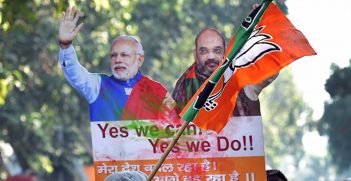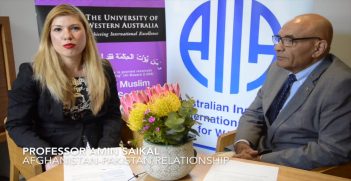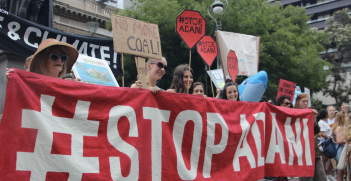Opening the Gates: The Kartarpur Corridor

The opening of the Kartarpur Corridor allowing Indian Sikhs to travel to a sacred Sikh site within Pakistan looks like a positive step in Indian-Pakistani relations. However, there may be ulterior motives.
This article was originally published on Australian Outlook on 21 November 2019.
One of the many persistent issues of the Partition of India in 1947 has been the dislocation of communities from their traditional cultural regions. The Partition not only subdivided the country, but also drove a border through two ethnolinguistic regions: Punjab to the west, and Bengal in the east. While India’s border with what came to be Bangladesh had (until recently) been porous enough to not create a wholesale impediment to traditional movement and exchange, the border with Pakistan quickly became hard and heavily fortified; separating families, communities, and institutions.
For followers of Sikhism this new border that cut through Punjab proved especially problematic. Sikhs overwhelmingly chose India over the newly formed Pakistan as the state that would best protect their interests (there are an estimated 50,000 Sikhs living in Pakistan today, compared to the 24 million in India). However, in making this choice, Sikhs became isolated from a number of their holiest sites, creating a religious disconnection that has proved a constant spiritual and emotional dilemma for the community.
India and Pakistan do have an agreement that provides a framework to approach this dilemma. The Protocol on Visits to Religious Shrines (1974) allows their respective citizens the opportunity to visit religious shrines in each country under certain conditions. The protocol recognises the deep shared history that permeates the region and understands that the cultural and religious requirements of their respective citizens need to be honoured outside the strategic animosity between the two states.
However, the agreement is often held hostage to this animosity. When tensions arise, both states become reluctant to issue visas to pilgrims, creating further resentment and suspicion between the countries. Yet a recent initiative developed by the Pakistan government has sought to ease at least one of these pressure points by providing an avenue for more consistent access for Sikhs to one of their most important religious sites.
Lying just 4.5 kilometres over the border in Pakistan is the Gurdwara Darbar Sahib, in the town of Kartarpur. The gurdwara (Sikh temple) is built where the religion’s founder – Guru Nanak Dev – spent the last 18 years of his life until his death in 1539. It is the place where Guru Nanak developed the three central pillars of Sikhism; mindfulness of the divine, altruism, and ethics of action. The pull of the site for Sikhs has been so great that a viewing platform had been erected on the Indian border where devotees could view the gurdwara in Pakistan through binoculars.
To mitigate this problem, last year the Pakistan government proposed the building of a corridor from the Indian border to the Gurdwara Darbar Sahib to allow Indian Sikhs visa-free access to the site. The gesture was seen as a component of what has come to be known as the “Bajwa Doctrine.” As a pseudo-junta, Pakistan’s army chief General Oamar Javed Bajwa is the country’s effective leader, and early in 2018 he made a series of speeches that seemed to signal Pakistan was willing to take a more cooperative approach to its neighbourhood (although this strategy was developed prior to New Delhi’s revoking Kashmir’s special status in the Indian federation, a move that reignited tension with Islamabad).
On November 9 the Kartarpur Corridor was inaugurated, with ceremonies on the Indian border – attended by Indian Prime Minister Narendra Modi – and at Kartarpur, attended by Pakistani Prime Minister Imran Khan. The opening of the corridor was timed to coincide with the 550th anniversary of Guru Nanak’s birth (his birthday follows the full moon in the Hindu calendar month of Kartik, overlapping October/November. It fell on 12 November this year).
While the opening of the corridor has proved a jubilant occasion for Indian Sikhs grateful to the Pakistani government for providing a more direct and consistent access to the gurdwara, the incessant suspicion that exists between the two states has led to a questioning of Pakistan’s motives. There remains a perception that rather than an act of goodwill towards India, or an initiative designed to alleviate one of the many civil society dilemmas created by the Partition, Pakistan is instead engaged in an act of deception. That is, with the creation of the corridor, Islamabad is playing a duplicitous game that will eventually reveal itself.
These suspicions are not without some merit. Previously, when Sikh pilgrims have entered Pakistan to visit other religious sites – like the Gurdwara Panja Sahib where there is a handprint said to be of Guru Nanak, or Guru Nanak’s birthplace, Nankana Sahib – Pakistani authorities, in conjunction with Sikh terrorist groups like Babbar Khalsa, have lined the routes to these sites with Sikh separatist propaganda. Islamabad has become particularly fond of promoting the work of a diaspora group (based in New York, Toronto, and London) called Sikhs For Justice, who have been agitating for a referendum on the establishment of a Sikh state called Khalistan.
The tactic from Pakistan has been to use this propaganda to try and instigate unrest in Indian Punjab in the hopes of destabilising India. As a country that was created on the idea that India cannot possibly function as a religiously plural state, Pakistan’s raison d’être is to prove this assertion correct. Its attempts to stoke separatist feelings among Indian Sikhs is one of the ways it attempts to do so. While a Sikh insurgency fermented in Indian Punjab in the 1980s, most Sikhs in India have now fully reconciled themselves with the Indian state and have no interest in separatism. Instead Khalistani sentiment finds its most prominent voices in the disconnected romanticism of the Sikh diaspora, as well as by Sikh groups inside Pakistan who gain support from the Pakistani state.
Islamabad’s encouragement of Khalistani sentiment seems oblivious to the fact that if a separate Sikh state were to come into existence, it would also make claims on Pakistani territory. Aside from the important religious sites in Pakistan, much of the territory of the Sikh Empire (1799 – 1849) is also now part of the country, including the empire’s capital, Lahore. The history of the empire forms an integral part of the mythology of Khalistan. But antagonism takes precedence over self-interest in relations between India and Pakistan.
This instinctive animosity was unfortunately on display as Imran Khan officially opened the corridor in Kartarpur. Unable to focus his speech on the joyful sentiments of the pilgrims and the historic act of cooperation between the two countries, Khan instead used the occasion to grandstand Pakistani concerns about Kashmir. In doing so he soured the spirit of the occasion for the Sikh community and undermined the movement towards greater bilateral trust that the initiative was meant to produce.
The creation of the Kartarpur Corridor is an important initiative designed to recognise the shared history of the region and alleviate one of the major dilemmas of the Partition of India. For the sake of the Sikh community it should be hoped that the project does not become hostage to the wider acrimony between the two countries. If it can be placed out of bounds for any of the countries’ tit-for-tat bickering, then New Delhi and Islamabad can use it as a model to identify other pressure points in the relationship and seek to develop workable solutions.
Grant Wyeth is a columnist for The Diplomat. His analysis focuses on Australia and the Pacific, India, and Canada.
This article is published under a Creative Commons Licence and may be republished with attribution.





